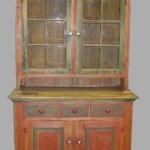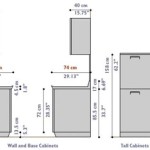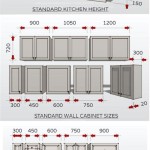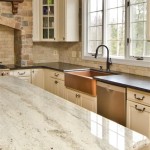Can You Replace Kitchen Countertops Without Damaging Cabinets?
Kitchen countertops are a focal point in any culinary space, both aesthetically and functionally. Over time, countertops can become worn, damaged, or simply outdated. Replacing them can breathe new life into a kitchen without undertaking a full-scale renovation. A common concern, however, is whether replacing countertops can be done without causing damage to the existing cabinets below. The answer is yes, it is possible, but careful planning, proper techniques, and a bit of caution are crucial for a successful outcome.
The ability to replace countertops without cabinet damage hinges on several factors. These include the existing cabinet construction, the method of countertop attachment, the type of new countertop being installed, and the skill of the installer. Understanding these factors is paramount before commencing the project.
Assessing Existing Cabinet Construction and Condition
The structural integrity of the cabinets is a primary consideration. Weak or unstable cabinets are more prone to damage during countertop removal and installation. Cabinets constructed from solid wood are generally more robust than those made from particleboard or MDF (Medium-Density Fiberboard). If the cabinets are showing signs of water damage, rot, or structural weakness, addressing these issues prior to countertop replacement is essential. Failing to do so could lead to further complications and potential cabinet failure during the process.
Inspect the cabinet boxes, especially the areas where the countertops are attached. Look for any signs of warping, cracking, or separation. Pay close attention to the cabinet bases, as these bear the weight of both the cabinets and the countertops. If the cabinets are in poor condition, reinforcing them before installing new countertops might be a worthwhile investment. This could involve adding bracing, reinforcing joints, or even replacing damaged sections.
The method by which the old countertops were installed also plays a critical role. Countertops are typically attached to cabinets using screws, adhesive, or a combination of both. Understanding the attachment method will inform the removal process and help prevent unnecessary force that could damage the cabinets.
Understanding Countertop Removal Techniques
The removal process is the most critical stage concerning potential cabinet damage. Patience and precision are key. The first step is to disconnect any plumbing or electrical fixtures connected to the countertop, such as sinks, faucets, and cooktops. This should be done by a qualified professional to ensure safety and proper disconnection.
Next, locate and remove any screws securing the countertop to the cabinets. These are typically found along the top edges of the cabinet boxes, inside the cabinet frames. In some cases, screws may be hidden under trim or within corner braces. Carefully inspect the underside of the countertop for any hidden fasteners before attempting to lift it.
If adhesive was used in addition to screws, it will be necessary to carefully separate the countertop from the cabinet boxes. This can be accomplished using a putty knife or a thin, flexible pry bar. Gently insert the tool between the countertop and the cabinet and apply steady pressure to break the adhesive bond. Work slowly and methodically, avoiding excessive force that could damage the cabinet surfaces. In some instances, a heat gun can be used to soften the adhesive, making it easier to separate the countertop.
For particularly stubborn adhesive, a oscillating multi-tool equipped with a scraper blade can be used. This tool allows for precise and controlled cutting of the adhesive without damaging the surrounding surfaces. Move the tool slowly and carefully, keeping the blade parallel to the cabinet surface to avoid gouging or scratching. Once all fasteners and adhesive have been removed, carefully lift the countertop off the cabinets. If the countertop is particularly heavy or unwieldy, enlist the help of another person to prevent accidental dropping and potential cabinet damage.
After the old countertop is removed, thoroughly clean the cabinet surfaces to remove any remaining adhesive or debris. This will provide a clean and level surface for the new countertop to rest upon. Inspect the cabinets again for any signs of damage or weakness, and make any necessary repairs before proceeding with the installation.
Considerations for New Countertop Installation
The type of new countertop being installed can also impact the risk of cabinet damage. Heavier materials, such as granite or concrete, place more stress on the cabinet structure than lighter materials, such as laminate or solid surface. If installing a heavier countertop, ensuring that the cabinets are adequately reinforced is crucial. This may involve adding additional support braces or shimming the cabinets to ensure they are level and evenly distributing the weight.
When installing the new countertop, use appropriate adhesives and fasteners that are compatible with both the countertop material and the cabinet construction. Apply adhesive sparingly to avoid excess squeeze-out that could be difficult to clean. Use screws that are the correct length to securely fasten the countertop without penetrating too far into the cabinet frame. Pre-drilling pilot holes can help prevent the wood from splitting and ensure a clean and secure connection.
Proper shimming is essential for achieving a level countertop surface. Use shims to fill any gaps between the countertop and the cabinet boxes, ensuring that the countertop is fully supported across its entire surface. Secure the shims in place with adhesive or small screws to prevent them from shifting over time.
During the installation process, be mindful of the weight of the countertop and avoid placing excessive pressure on the cabinets. Use lifting devices or dollies to move heavy countertops into place and avoid dragging them across the cabinet surfaces. If necessary, protect the cabinet surfaces with padding or blankets to prevent scratches or dents.
Finally, take the time to properly seal the edges and seams of the new countertop to prevent water damage and maintain its longevity. Use a high-quality sealant that is designed for use in kitchens and bathrooms and follow the manufacturer's instructions carefully.
Replacing kitchen countertops without damaging cabinets is achievable with careful planning, attention to detail, and proper techniques. By assessing the existing cabinet condition, understanding the countertop removal process, and taking precautions during the installation of the new countertop, the risk of damage can be minimized, resulting in a successful and aesthetically pleasing kitchen upgrade.

Can You Replace Kitchen Countertops Without Damaging Cabinets The Countertop Factory

Update Your Countertops Without Replacing Them

The Risks Of Replacing Your Countertop Before Cabinets

Change The Color Of Laminate Countertops Without Replacing Them

Can You Replace Just The Countertop Factory

Can I Replace My Countertops Without Replacing Cabinets

Kitchen Removing Base Cabinet Countertops Backsplash

The Risks Of Replacing Your Countertop Before Cabinets

How To Remove Quartz Countertop Without Breaking It Granite Selection

How To Replace Kitchen Cabinets Without Replacing Countertops Nj
Related Posts








